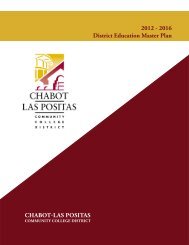City College of San Francisco - California Competes
City College of San Francisco - California Competes
City College of San Francisco - California Competes
You also want an ePaper? Increase the reach of your titles
YUMPU automatically turns print PDFs into web optimized ePapers that Google loves.
STANDARD II.A<br />
The Intensive English Language Program was<br />
developed as a result <strong>of</strong> a feasibility study conducted<br />
during the 1991-92 academic year. This<br />
noncredit program is designed for international<br />
students with F-1 visas and prepares these students<br />
for further academic study and taking the<br />
Test <strong>of</strong> English as a Foreign Language (TOEFL)<br />
exam. The Academic Program for International<br />
Students serves approximately 300 students<br />
annually and is designed to provide access to<br />
international students who wish to enroll in<br />
degree-applicable coursework. [Ref. 13]<br />
The Study Abroad Programs provide students an<br />
opportunity to study and live in another country<br />
while receiving college credit. These programs<br />
are intended to enable students to experience<br />
the host country’s culture, language and history<br />
and develop a global perspective through their<br />
experiences. [Ref. 4]<br />
Short-term training courses are also <strong>of</strong>fered<br />
through various vocational education programs.<br />
These credit courses are designed to satisfy<br />
immediate labor market demands <strong>of</strong> business<br />
and industry. The focus is on serving incumbent<br />
or displaced workers. Outcome data for these<br />
programs are found in the Vocational and<br />
Technical Education Act (VTEA) Core Indicator<br />
Report produced by the <strong>California</strong> State<br />
Chancellor’s Office. The quality <strong>of</strong> the credit<br />
and noncredit courses and programs <strong>of</strong>fered as<br />
short-term training through the institution’s<br />
vocational education program is evaluated<br />
through the Program Review process, the Core<br />
Indicators Report, and faculty evaluations. Low<br />
enrollment has forced some programs to reflect<br />
on ways <strong>of</strong> improving course <strong>of</strong>ferings. Programs<br />
that require licensing by an outside agency provide<br />
information on student success rates that<br />
are used to assess program effectiveness. [Ref. 14]<br />
The institution <strong>of</strong>fers a General Education<br />
Development (GED) Program. This program is<br />
designed for students who wish to obtain a GED<br />
certificate in lieu <strong>of</strong> a high school diploma. The<br />
coursework for this program has been developed<br />
by the Transitional Studies Department and is<br />
<strong>of</strong>fered at several sites. Students who successfully<br />
complete the coursework may sit for an examination<br />
developed by the American Council on<br />
Education. During the 2003-04 academic year,<br />
793 students sat for the exam with 435 students<br />
passing the exam. [Ref. 15] A High School<br />
Diploma Program is also <strong>of</strong>fered to those students<br />
who have completed a significant portion<br />
<strong>of</strong> their high school coursework and wish to<br />
complete the remaining credits necessary to<br />
acquire their diploma.<br />
II.A.2.a. The institution uses established procedures<br />
to design, identify learning outcomes,<br />
approve, administer, deliver and evaluate<br />
courses and programs. The institution recognizes<br />
the central role <strong>of</strong> its faculty for establishing<br />
quality and improving instructional courses<br />
and programs.<br />
The institution identifies areas <strong>of</strong> need with<br />
regard to courses and programs in several ways.<br />
Based on placement testing in Mathematics,<br />
English, and ESL, the Office <strong>of</strong> Research,<br />
Planning and Grants provides the institution<br />
with a pr<strong>of</strong>ile <strong>of</strong> incoming students. In addition,<br />
this <strong>of</strong>fice collects data on other student characteristics<br />
as well as economic and population data<br />
for the Bay Area. Community needs are brought<br />
to the attention <strong>of</strong> the institution through listening<br />
sessions that are incorporated into the<br />
Strategic Plan. Many vocational programs and<br />
most campuses have advisory boards that provide<br />
feedback regarding the needs <strong>of</strong> specific<br />
communities served. This feedback is incorporated<br />
into the decision-making process affecting the<br />
administration, mode <strong>of</strong> delivery, and evaluation<br />
<strong>of</strong> courses and programs <strong>of</strong>fered. Moreover,<br />
the Chancellor participates on the Executive<br />
Committee <strong>of</strong> the local Workforce Investment<br />
Board that is charged with identifying<br />
workforce needs.<br />
Once curriculum needs are identified, the curriculum<br />
development process begins. In order<br />
to assist faculty in the development <strong>of</strong> new<br />
curriculum, the <strong>College</strong> Curriculum Committee,<br />
with the support <strong>of</strong> the Office <strong>of</strong> Instruction,<br />
has provided numerous workshops that focus<br />
on curriculum development. These workshops<br />
are <strong>of</strong>fered to faculty semiannually during FLEX<br />
Day activities. Additional resources include the<br />
116 CITY COLLEGE OF SAN FRANCISCO







